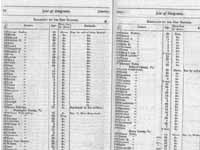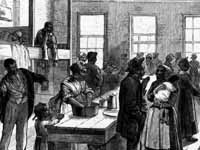Personal Stories and ACS New Directions

|
Before the Civil War, Robert E. Lee freed most of
his slaves and offered to pay expenses for those who wanted to
go to Liberia. In November 1853, Lee's former slaves William and
Rosabella Burke and their four children sailed on the Banshee,
which left Baltimore with 261 emigrants. A person of superior intelligence
and drive, Burke studied Latin and Greek at a newly established
seminary in Monrovia and became a Presbyterian minister in 1857.
He helped educate his own children and other members of his community
and took several native children into his home. The Burkes's letters
describing their lives in Liberia show that they relied on the
Lees to convey messages to and from relatives still in Virginia,
and the letters also reflect affection for their former masters.
"Table of Emigrants," in The African Repository and Colonial
Journal, vol. 30, no. 1, January 1854, p. 121 Journal General
Collections (17)
|

|
Despite the hardships of being a colonist, William
Burke was enthusiastic about his new life. After five years in
Liberia he wrote that "Persons coming to Africa should expect to
go through many hardships, such as are common to the first settlement
in any new country. I expected it, and was not disappointed or
discouraged at any thing I met with; and so far from being dissatisfied
with the country, I bless the Lord that ever my lot was cast in
this part of the earth. The Lord has blessed me abundantly since
my residence in Africa, for which I feel that I can never be sufficiently
thankful."
[Letter from William Burke to ACS president Ralph R. Gurley],
July 26, 1858 American Colonization Society Papers Manuscript
Division (18)
|

|
Letters from the Burkes to Mary Custis Lee, wife
of Robert E. Lee, were published in the 1859 edition of The
African Repository with Mrs. Lee's permission. This letter
from Mrs. Burke to Mrs. Lee demonstrates personal warmth between
the two women. Mrs. Burke shows concern for Mrs. Lee's health,
tells Mrs. Lee about her children, and asks about the Lee children.
The "little Martha" referred to was Martha Custis Lee Burke, born
in Liberia and named for one of the Lee family. Repeating her husband's
enthusiasm for their new life, Rosabella Burke says, "I love Africa
and would not exhange it for America."
[Letter from Rosabella Burke to Mary Custis Lee], February 20,
1859, in The African Repository and Colonial Journal,
vol. 35, no 7, July 1859, p. 216 General
Collections (20)
|

|
The ACS required potential emigrants to complete
a form as part of their application for settlement in Liberia.
This example lists twelve slaves whose master, Timothy Rogers of
Bedford County, Virginia, freed them in his will under the condition
that they go to Liberia. A note reveals that one of the group preferred
to remain a slave if he were unable to free his wife, the property
of another owner, to go with him. Forms like this provide a wealth
of demographic and genealogical information about emigrants to
Liberia.
"Applicants for Passage to Liberia," ca. 1852 American Colonization
Society Papers Manuscript
Division (21)
|

|
Because the soil around Monrovia was poor and the
coastal areas were covered in dense jungle, many early emigrants
to Liberia moved up the nearby St. Paul's River, where they found
land suitable for farming. There they established small communities
of people from the same geographic region in America. This photograph
gives an idea of the appearance of the countryside in which the
settlers began their new lives.
St. Paul's River, Liberia, ca. 1900 Photomural from silver-gelatin
print Prints and Photographs
Division (23)
|

|
In 1867, the American Colonization Society published
this list showing the names of ships, dates of sailing, and number
of emigrants by state through December 1866. By that time, more
than 13,000 blacks had been settled in Liberia through ACS efforts.
The peak years were between 1848 and 1854, when the society chartered
forty-one ships and transported nearly 4,000 colonists. After falling
to the twenties in 1863 and 1864, the numbers went up again after
the Civil War, when 527 people went in 1865 and 621 in 1866. The
table shows that the 3,733 Virginia emigrants were the largest
group, followed by North Carolina with 1,371, and Georgia with
1,341.
"Table of Emigrants Settled in Liberia by the American Colonization
Society," in The African Repository and Colonial Journal, vol.
43, no. 4, April 1867, p. 117 General
Collections (24)
|

|
In the spring of 1880, a group of 150 African-Americans
from Arkansas was living in temporary quarters at Mt. Olivet Baptist
Chapel on 37th Street in New York before going to Liberia. Because
the ACS had chartered the only ship that regularly went to Liberia,
this group, which was going under its own auspices, was trying
to charter another ship. The article that described their circumstances,
entitled "Colored Exodus from Arkansas," stated that another 50,000
blacks were preparing to emigrate from the Gulf states to Arizona
and New Mexico, where they planned to purchase farm land.
"Refugees awaiting transportation to Liberia at Mr. Olivet Baptist
Chapel, New York City" From, Frank Leslie's Illustrated News, April
24, 1880, p. 120 Photomural from woodcut Prints
and Photographs Division (25)
|

|
In 1892, the ACS abandoned publication of The
African Repository and replaced it with Liberia. The
name change reflected a new direction for the society, as announced
in the first issue of Liberia. Instead of aiding emigrants,
the ACS turned its attention to the question of "How can the
society best help and strengthen Liberia?" The society committed
itself to fostering a public-school system in Liberia, promoting
more frequent ships between the U.S. and Liberia, collecting
and diffusing more reliable information about Liberia, and enabling
Liberia to depend more on herself. Future colonists were to be
selected with a view to the needs of Liberia, not their own situations.
An example of this preferred type of colonist was Miss Georgia
Patton, described in an early issue of Liberia. Well-educated,
Miss Patton planned to practice medicine and teach school in
Liberia. She also shared the ACS goals of doing good for others
and spreading Christianity and civilization in Africa.
"Brief Autobiography of a Colored Woman Who Has Recently Emigrated
to Liberia," in Liberia, no. 3, November 1893, pp.
78-79 General Collections (26)
"Dey's Mission, Liberia," ca. 1900 Photomural from silver-gelatin
print Prints and Photographs
Division (27)
|

|
In the summer of 1919, Henry Bonds, still in the
U.S. and having moved to Tullahassee, Oklahoma, wrote the society
once again about going to Liberia. He pointed out that World War
I had stopped him, but that he still wanted to go and wanted to
know if the aid promised him was still good. A number of letters
between Bonds and the ACS exist, but they do not answer the question
whether or not Bonds ever reached Liberia. Perhaps further research
could provide the answer and more information about Bonds and his
family.
[Letter from Henry Bonds of Tullahassee, Oklahoma], August
25, 1919 Holograph American Colonization Society Papers Manuscript
Division (28)
|

|
In 1912, Henry Young Bonds of Vian, Oklahoma, began
correspondence with the ACS about going to Liberia. As part of
his application, Bonds sent in this formal, notarized form. Bonds
expected to defray half of the $591 he needed as passage money
for himself and his family and asked the ACS for the other part.
He planned to sell his land to raise money for support while getting
established in Liberia. After a two-year application process, Bond's
request was approved by the ACS. He planned to sail in October
1914, but was prevented from doing so by the outbreak of World
War I.
[Formal application of Henry Bonds to emigrate to Liberia],
1913 Legal document American Colonization Society Papers Manuscript
Division (29)
|

|
As part of his application for ACS aid in emigrating
to Liberia, Henry Bonds submitted a postcard with a photograph
of his family. Left to right are Catherine, eight; Bonds; Loretta,
three; Bonds's wife Mary; and Floyd, six. Not pictured are two
unnamed older, married children, perhaps from an earlier marriage,
who did not wish to emigrate. Born in 1864 near Guntown, Mississippi,
Bonds had come to Indian Territory (now Oklahoma) in April 1890.
His wife Mary, thirty, born in Indian Territory near Tahlequah,
was educated in the Cherokee colored high school and had taught
in the Vian colored school.
[Henry Y. Bonds and family], ca. 1912 Photomural from silver-gelatin
print American Colonization Society Papers Manuscript
Division (30)
|

|
Because the American Colonization Society was very
concerned about the character of emigrants they sent to Liberia,
applicants had to submit letters of recommendation. This highly
favorable letter came from officials of the Citizens Bank of Vian.
Bonds also supplied one from J.H. Dodd, M.D., who said that Bonds
had "a host of friends in all the races" and that his family was "regarded
as one of the very best in the country."
[Letter of recommendation for Henry Bonds], 1913 American Colonization
Society Papers Manuscript
Division (31)
|

|
Beginning in the early 1800s, Cherokees, Choctaws,
and other eastern Native American tribes signed treaties giving
up southeastern land in return for land west of the Mississippi
in what became known as Indian Territory, or even later, Oklahoma.
In addition, some tribes were removed to the areas by force. After
the Civil War, the United States government confiscated territory
from Native Americans who had supported the Confederacy and, in
1889, opened that land to other settlers. This map of the Vian
area shows land owned by Henry Bonds's children. A plot in the
left corner of section 34 and one in the lower middle are assigned
to his daughter Catherine Bonds, "N.B.F.," which stands for "new-born
freedman," a term apparently applied to blacks born after Emancipation,
as well as former slaves. The plot labeled N.B.F. 457, is also
probably part of a Bonds claim. It is unclear why the land was
in the children's names.
[Map of Vian area] Indian Territory: Cherokee Nation Muskogee,
Indian Territory [Oklahoma]: Indian Territory Map Company, 1909
Photomural Geography
and Map Division (32)
|
![[Campus of Booker T. Washington Institute in Liberia]](images/campus0.jpg)
![[Letter about ACS support for Booker T. Washington Institute]](images/support0.jpg)
ACS Supports Liberian Education [campus][letter]
|
The Booker T. Washington Institute at Kakata, Liberia,
was founded in 1929 by a group of American missionary and philanthropic
organizations, including the American Colonization Society. Like
Tuskegee Institute, the school emphasized vocational training and
prepared many young Liberians for jobs in agriculture, auto mechanics,
carpentry, masonry, and other trades. The campus of the institute
was built on a 1,000-acre tract of land granted by the Liberian
government. As the accompanying letter shows, the ACS provided
funding for the institution.
Campus of Booker T. Washington Institute in Liberia, ca.
1940 Photomural from silver-gelatin print Prints
and Photographs Division (33)
[Letter about ACS support for Booker T. Washington Institute],
June 10, 1940 Typed letter American Colonization Society Papers Manuscript
Division (34) |
|